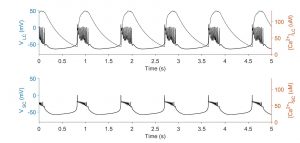Title of Abstract: Octopamine modulates a biologically realistic model of the crustacean cardiac ganglion
Names of Mentors: Patsy Dickinson; Daniel Powell
Mentors’ Organizations or Departments: Department of Biology, Bowdoin College; Department of Neuroscience, Brandeis University

Research Abstract: Central pattern generators, or CPGs, are neural circuits that can produce rhythmic patterns of activity. CPGs control rhythmic behaviors like breathing and locomotion. CPG output must be flexible for animals to react appropriately to the environment. To this end, CPGs respond to a variety of neuromodulators. The cardiac ganglion of Homarus americanus, the American lobster, is a CPG that controls lobster cardiac activity. It consists of 5 large cells and 4 small cells. Experiments have shown that octopamine increases burst duration and frequency and modulates the phase relationship of large cell and small cell firing. The mechanism of octopaminergic modulation, however, is unknown. We created a biorealistic model of the cardiac ganglion and tested several hypotheses for octopaminergic modulation. We found that octopamine changes the current IH in large cells to increase burst duration and frequency.
 Arjun Mehta ’21
Arjun Mehta ’21